E-Waste: Analysis of Environmental Impact and Management
VerifiedAdded on 2022/08/27
|8
|2231
|57
Report
AI Summary
This report examines the escalating issue of e-waste, driven by the rapid growth of electrical and electronic equipment and technological advancements. It explores the environmental consequences of improper e-waste management, emphasizing the hazardous materials within these devices and the risks of landfilling. The report analyzes three key articles published in 2003, 2007, and 2015, which discuss mechanical recycling, global environmental problems, and the role of Extended Producer Responsibility (EPR) and Producer Responsibility Organizations (PRO) in e-waste management. The report highlights the challenges in developing countries, the importance of disassembly and recycling, and the need for stricter regulations to ensure effective e-waste management. It underscores the importance of sustainable practices and the development of new technologies to address the growing e-waste crisis.
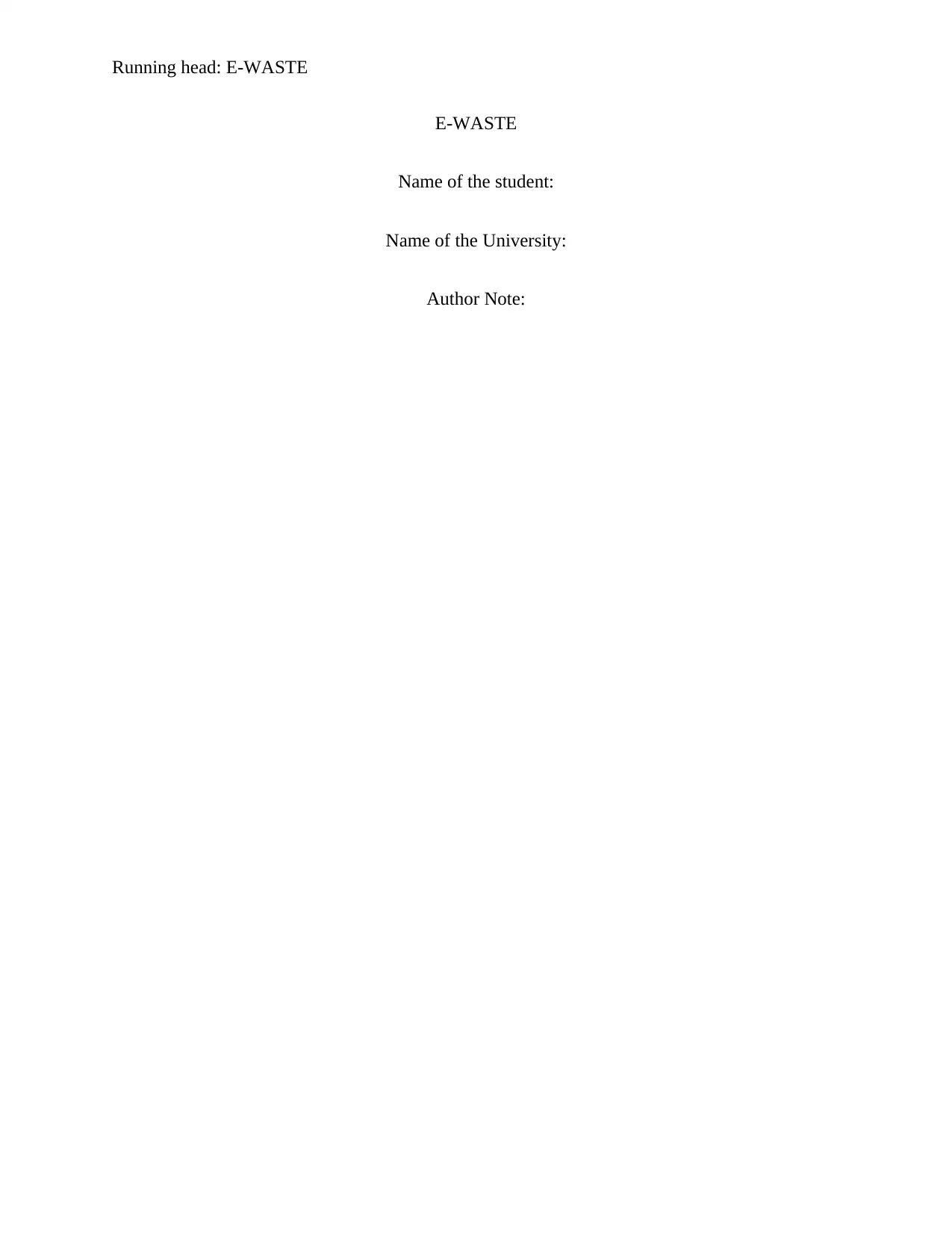
Running head: E-WASTE
E-WASTE
Name of the student:
Name of the University:
Author Note:
E-WASTE
Name of the student:
Name of the University:
Author Note:
Paraphrase This Document
Need a fresh take? Get an instant paraphrase of this document with our AI Paraphraser
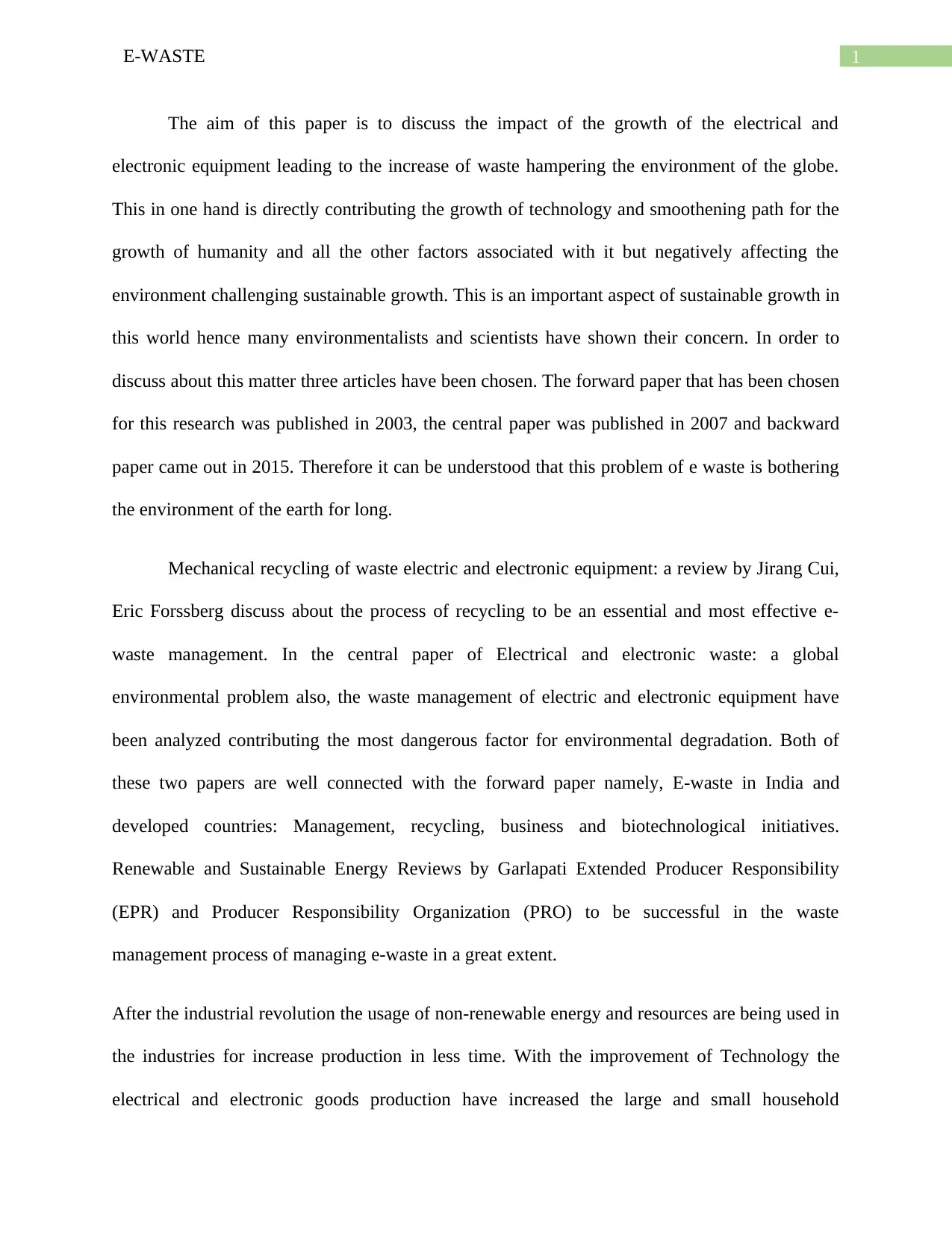
1E-WASTE
The aim of this paper is to discuss the impact of the growth of the electrical and
electronic equipment leading to the increase of waste hampering the environment of the globe.
This in one hand is directly contributing the growth of technology and smoothening path for the
growth of humanity and all the other factors associated with it but negatively affecting the
environment challenging sustainable growth. This is an important aspect of sustainable growth in
this world hence many environmentalists and scientists have shown their concern. In order to
discuss about this matter three articles have been chosen. The forward paper that has been chosen
for this research was published in 2003, the central paper was published in 2007 and backward
paper came out in 2015. Therefore it can be understood that this problem of e waste is bothering
the environment of the earth for long.
Mechanical recycling of waste electric and electronic equipment: a review by Jirang Cui,
Eric Forssberg discuss about the process of recycling to be an essential and most effective e-
waste management. In the central paper of Electrical and electronic waste: a global
environmental problem also, the waste management of electric and electronic equipment have
been analyzed contributing the most dangerous factor for environmental degradation. Both of
these two papers are well connected with the forward paper namely, E-waste in India and
developed countries: Management, recycling, business and biotechnological initiatives.
Renewable and Sustainable Energy Reviews by Garlapati Extended Producer Responsibility
(EPR) and Producer Responsibility Organization (PRO) to be successful in the waste
management process of managing e-waste in a great extent.
After the industrial revolution the usage of non-renewable energy and resources are being used in
the industries for increase production in less time. With the improvement of Technology the
electrical and electronic goods production have increased the large and small household
The aim of this paper is to discuss the impact of the growth of the electrical and
electronic equipment leading to the increase of waste hampering the environment of the globe.
This in one hand is directly contributing the growth of technology and smoothening path for the
growth of humanity and all the other factors associated with it but negatively affecting the
environment challenging sustainable growth. This is an important aspect of sustainable growth in
this world hence many environmentalists and scientists have shown their concern. In order to
discuss about this matter three articles have been chosen. The forward paper that has been chosen
for this research was published in 2003, the central paper was published in 2007 and backward
paper came out in 2015. Therefore it can be understood that this problem of e waste is bothering
the environment of the earth for long.
Mechanical recycling of waste electric and electronic equipment: a review by Jirang Cui,
Eric Forssberg discuss about the process of recycling to be an essential and most effective e-
waste management. In the central paper of Electrical and electronic waste: a global
environmental problem also, the waste management of electric and electronic equipment have
been analyzed contributing the most dangerous factor for environmental degradation. Both of
these two papers are well connected with the forward paper namely, E-waste in India and
developed countries: Management, recycling, business and biotechnological initiatives.
Renewable and Sustainable Energy Reviews by Garlapati Extended Producer Responsibility
(EPR) and Producer Responsibility Organization (PRO) to be successful in the waste
management process of managing e-waste in a great extent.
After the industrial revolution the usage of non-renewable energy and resources are being used in
the industries for increase production in less time. With the improvement of Technology the
electrical and electronic goods production have increased the large and small household

2E-WASTE
appliances, cellular telephone, computers, games and peripherals, portable electronic devices,
MP3 players, camera, electrical tools and video and audio equipment come under electronic and
electrical goods. In addition to this different everyday commodities like air cooler air
conditioner, refrigerators, television, VCD, VCR, set top box and most importantly mobile
phones are embedded in the commodities other than computers. These also contribute a larger
part in the electronics and electrical appliances which are becoming a major concern to e-waste
management problem. This products are used properly and come to the end of their life they
become electronic waste. They use electronic current and electromagnetic fields to work and
help in generating transferring and measuring current. All of these devices after being used go to
disposal and when these e waste are not properly managed then the actual problem arises.
WEEE is one of the fastest growing industry waste and the disposal rate is accelerating
divided. This is due to the fact that the demand of these electronic and electrical appliances in the
markets are high and the customers are trying to jump to the latest technology every time. For
example if a mobile phone is introduced with high quality feature then the customer try to grab
this offer immediately. However, the technological changes get upgraded every time the already
bought product gets lagged behind in terms of latest technology one for that matter features.
Then again the customer decides to dispose this latest phone he had bought a year ago and buy
the latest model. Now this mobile phone which the customer had bought a short while leads to
increase the e-waste immediately. This is taking place every day because the customer Trend in
grabbing the latest technology is increasing. With larger population having the buying capacity
of the latest technology leads to higher number of WEEE and in the case of highly developed
countries the rate of WEEE growth is higher. The per capita waste production in the developing
countries on the other hand is relatively small but these are becoming the fastest growing
appliances, cellular telephone, computers, games and peripherals, portable electronic devices,
MP3 players, camera, electrical tools and video and audio equipment come under electronic and
electrical goods. In addition to this different everyday commodities like air cooler air
conditioner, refrigerators, television, VCD, VCR, set top box and most importantly mobile
phones are embedded in the commodities other than computers. These also contribute a larger
part in the electronics and electrical appliances which are becoming a major concern to e-waste
management problem. This products are used properly and come to the end of their life they
become electronic waste. They use electronic current and electromagnetic fields to work and
help in generating transferring and measuring current. All of these devices after being used go to
disposal and when these e waste are not properly managed then the actual problem arises.
WEEE is one of the fastest growing industry waste and the disposal rate is accelerating
divided. This is due to the fact that the demand of these electronic and electrical appliances in the
markets are high and the customers are trying to jump to the latest technology every time. For
example if a mobile phone is introduced with high quality feature then the customer try to grab
this offer immediately. However, the technological changes get upgraded every time the already
bought product gets lagged behind in terms of latest technology one for that matter features.
Then again the customer decides to dispose this latest phone he had bought a year ago and buy
the latest model. Now this mobile phone which the customer had bought a short while leads to
increase the e-waste immediately. This is taking place every day because the customer Trend in
grabbing the latest technology is increasing. With larger population having the buying capacity
of the latest technology leads to higher number of WEEE and in the case of highly developed
countries the rate of WEEE growth is higher. The per capita waste production in the developing
countries on the other hand is relatively small but these are becoming the fastest growing
⊘ This is a preview!⊘
Do you want full access?
Subscribe today to unlock all pages.

Trusted by 1+ million students worldwide
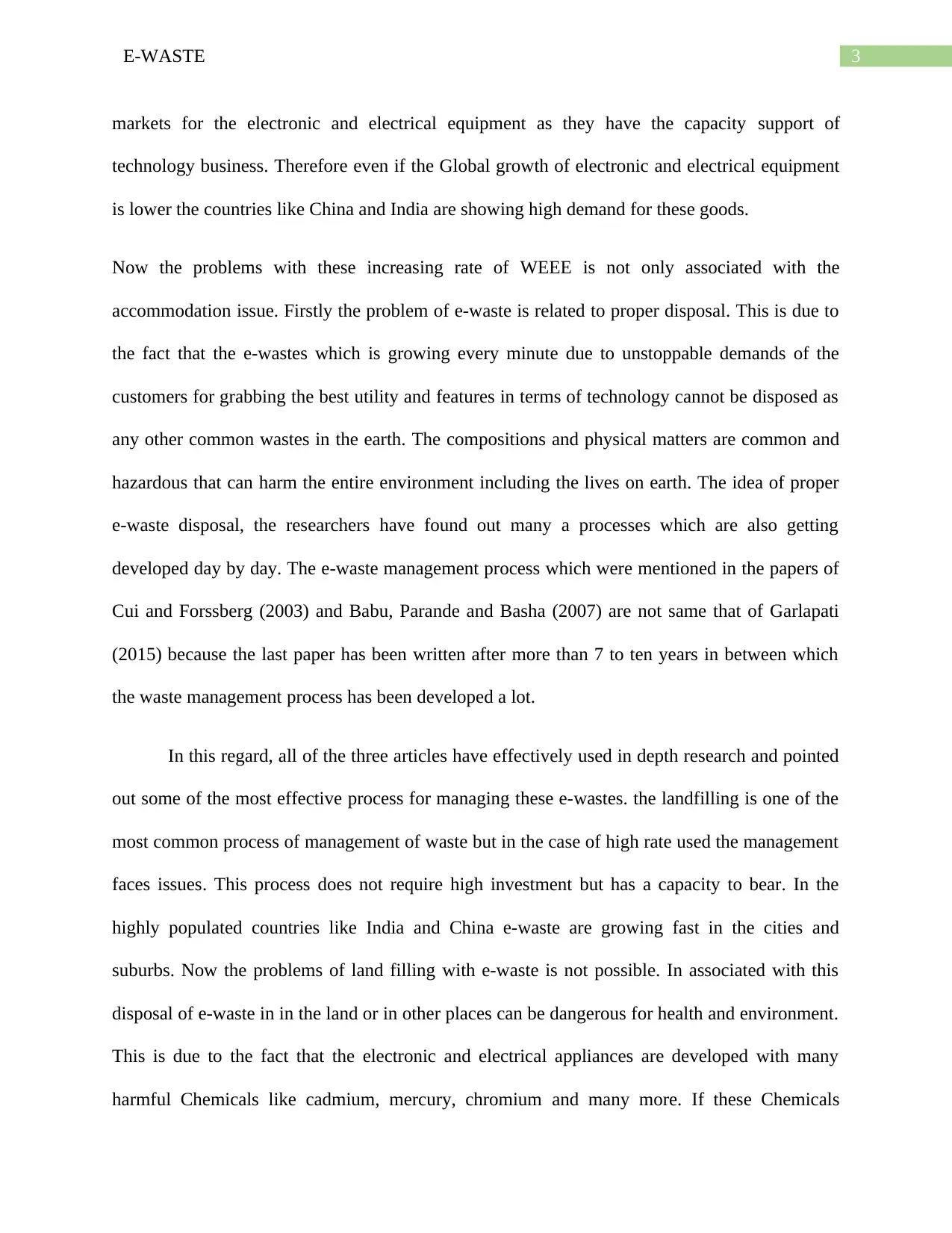
3E-WASTE
markets for the electronic and electrical equipment as they have the capacity support of
technology business. Therefore even if the Global growth of electronic and electrical equipment
is lower the countries like China and India are showing high demand for these goods.
Now the problems with these increasing rate of WEEE is not only associated with the
accommodation issue. Firstly the problem of e-waste is related to proper disposal. This is due to
the fact that the e-wastes which is growing every minute due to unstoppable demands of the
customers for grabbing the best utility and features in terms of technology cannot be disposed as
any other common wastes in the earth. The compositions and physical matters are common and
hazardous that can harm the entire environment including the lives on earth. The idea of proper
e-waste disposal, the researchers have found out many a processes which are also getting
developed day by day. The e-waste management process which were mentioned in the papers of
Cui and Forssberg (2003) and Babu, Parande and Basha (2007) are not same that of Garlapati
(2015) because the last paper has been written after more than 7 to ten years in between which
the waste management process has been developed a lot.
In this regard, all of the three articles have effectively used in depth research and pointed
out some of the most effective process for managing these e-wastes. the landfilling is one of the
most common process of management of waste but in the case of high rate used the management
faces issues. This process does not require high investment but has a capacity to bear. In the
highly populated countries like India and China e-waste are growing fast in the cities and
suburbs. Now the problems of land filling with e-waste is not possible. In associated with this
disposal of e-waste in in the land or in other places can be dangerous for health and environment.
This is due to the fact that the electronic and electrical appliances are developed with many
harmful Chemicals like cadmium, mercury, chromium and many more. If these Chemicals
markets for the electronic and electrical equipment as they have the capacity support of
technology business. Therefore even if the Global growth of electronic and electrical equipment
is lower the countries like China and India are showing high demand for these goods.
Now the problems with these increasing rate of WEEE is not only associated with the
accommodation issue. Firstly the problem of e-waste is related to proper disposal. This is due to
the fact that the e-wastes which is growing every minute due to unstoppable demands of the
customers for grabbing the best utility and features in terms of technology cannot be disposed as
any other common wastes in the earth. The compositions and physical matters are common and
hazardous that can harm the entire environment including the lives on earth. The idea of proper
e-waste disposal, the researchers have found out many a processes which are also getting
developed day by day. The e-waste management process which were mentioned in the papers of
Cui and Forssberg (2003) and Babu, Parande and Basha (2007) are not same that of Garlapati
(2015) because the last paper has been written after more than 7 to ten years in between which
the waste management process has been developed a lot.
In this regard, all of the three articles have effectively used in depth research and pointed
out some of the most effective process for managing these e-wastes. the landfilling is one of the
most common process of management of waste but in the case of high rate used the management
faces issues. This process does not require high investment but has a capacity to bear. In the
highly populated countries like India and China e-waste are growing fast in the cities and
suburbs. Now the problems of land filling with e-waste is not possible. In associated with this
disposal of e-waste in in the land or in other places can be dangerous for health and environment.
This is due to the fact that the electronic and electrical appliances are developed with many
harmful Chemicals like cadmium, mercury, chromium and many more. If these Chemicals
Paraphrase This Document
Need a fresh take? Get an instant paraphrase of this document with our AI Paraphraser
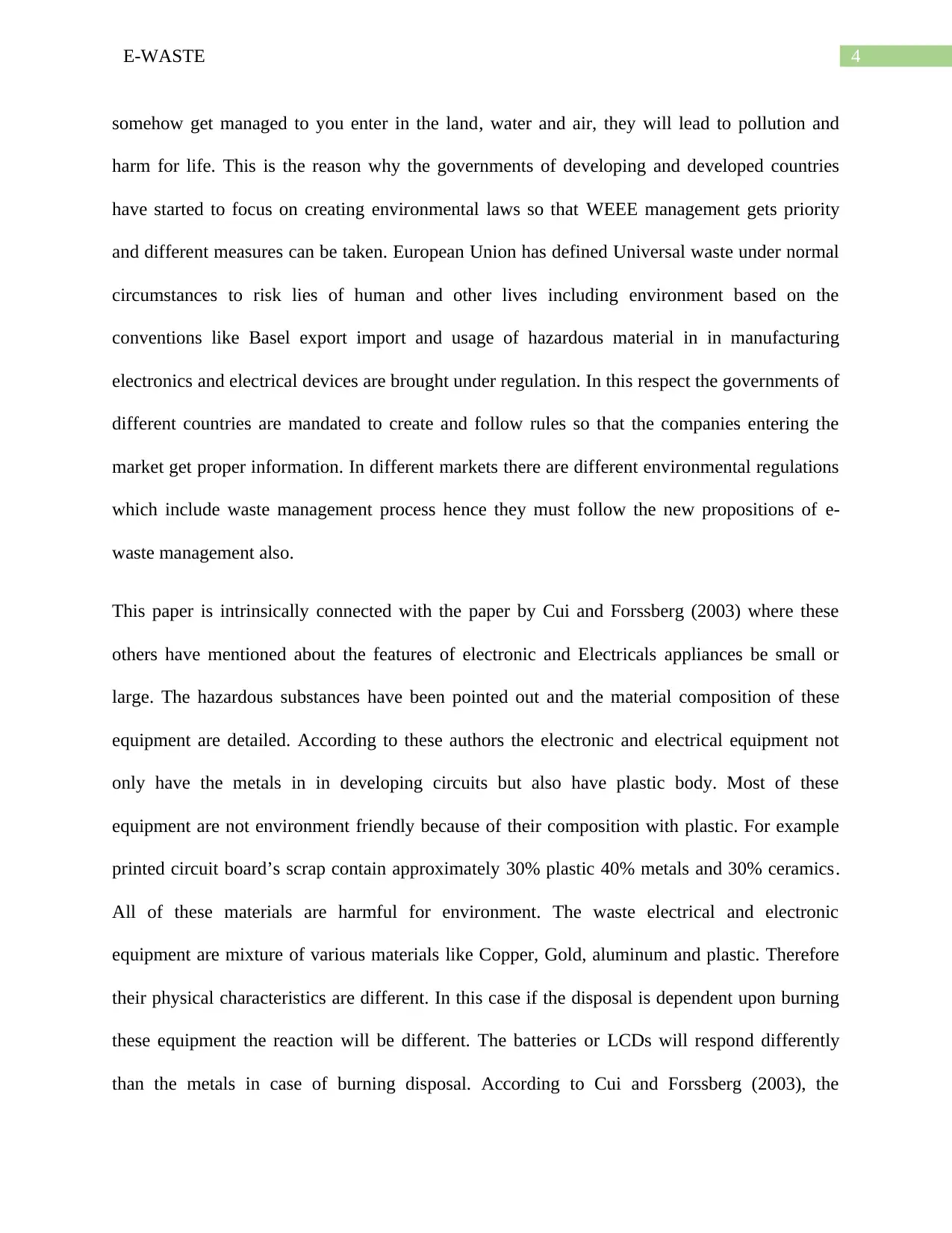
4E-WASTE
somehow get managed to you enter in the land, water and air, they will lead to pollution and
harm for life. This is the reason why the governments of developing and developed countries
have started to focus on creating environmental laws so that WEEE management gets priority
and different measures can be taken. European Union has defined Universal waste under normal
circumstances to risk lies of human and other lives including environment based on the
conventions like Basel export import and usage of hazardous material in in manufacturing
electronics and electrical devices are brought under regulation. In this respect the governments of
different countries are mandated to create and follow rules so that the companies entering the
market get proper information. In different markets there are different environmental regulations
which include waste management process hence they must follow the new propositions of e-
waste management also.
This paper is intrinsically connected with the paper by Cui and Forssberg (2003) where these
others have mentioned about the features of electronic and Electricals appliances be small or
large. The hazardous substances have been pointed out and the material composition of these
equipment are detailed. According to these authors the electronic and electrical equipment not
only have the metals in in developing circuits but also have plastic body. Most of these
equipment are not environment friendly because of their composition with plastic. For example
printed circuit board’s scrap contain approximately 30% plastic 40% metals and 30% ceramics.
All of these materials are harmful for environment. The waste electrical and electronic
equipment are mixture of various materials like Copper, Gold, aluminum and plastic. Therefore
their physical characteristics are different. In this case if the disposal is dependent upon burning
these equipment the reaction will be different. The batteries or LCDs will respond differently
than the metals in case of burning disposal. According to Cui and Forssberg (2003), the
somehow get managed to you enter in the land, water and air, they will lead to pollution and
harm for life. This is the reason why the governments of developing and developed countries
have started to focus on creating environmental laws so that WEEE management gets priority
and different measures can be taken. European Union has defined Universal waste under normal
circumstances to risk lies of human and other lives including environment based on the
conventions like Basel export import and usage of hazardous material in in manufacturing
electronics and electrical devices are brought under regulation. In this respect the governments of
different countries are mandated to create and follow rules so that the companies entering the
market get proper information. In different markets there are different environmental regulations
which include waste management process hence they must follow the new propositions of e-
waste management also.
This paper is intrinsically connected with the paper by Cui and Forssberg (2003) where these
others have mentioned about the features of electronic and Electricals appliances be small or
large. The hazardous substances have been pointed out and the material composition of these
equipment are detailed. According to these authors the electronic and electrical equipment not
only have the metals in in developing circuits but also have plastic body. Most of these
equipment are not environment friendly because of their composition with plastic. For example
printed circuit board’s scrap contain approximately 30% plastic 40% metals and 30% ceramics.
All of these materials are harmful for environment. The waste electrical and electronic
equipment are mixture of various materials like Copper, Gold, aluminum and plastic. Therefore
their physical characteristics are different. In this case if the disposal is dependent upon burning
these equipment the reaction will be different. The batteries or LCDs will respond differently
than the metals in case of burning disposal. According to Cui and Forssberg (2003), the
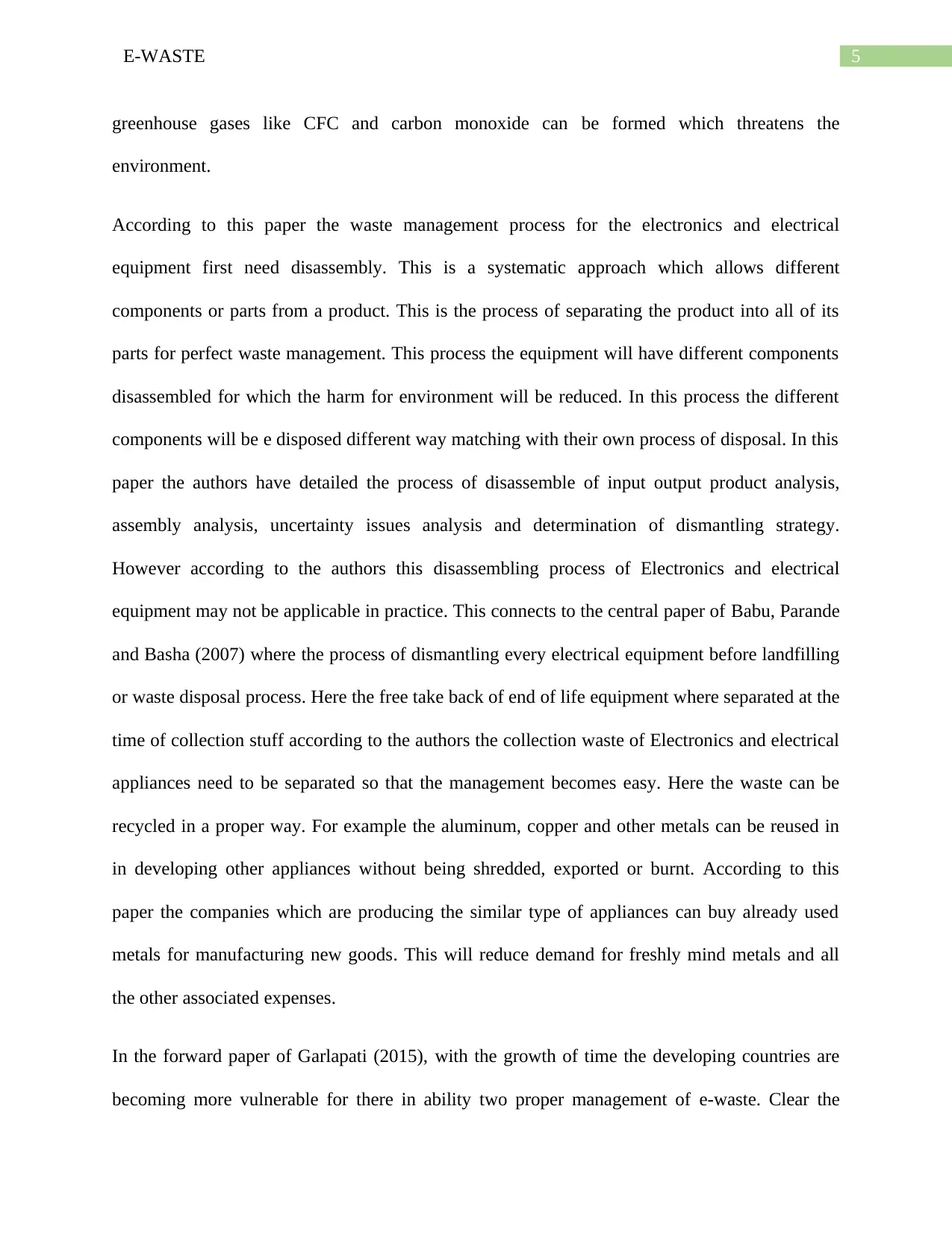
5E-WASTE
greenhouse gases like CFC and carbon monoxide can be formed which threatens the
environment.
According to this paper the waste management process for the electronics and electrical
equipment first need disassembly. This is a systematic approach which allows different
components or parts from a product. This is the process of separating the product into all of its
parts for perfect waste management. This process the equipment will have different components
disassembled for which the harm for environment will be reduced. In this process the different
components will be e disposed different way matching with their own process of disposal. In this
paper the authors have detailed the process of disassemble of input output product analysis,
assembly analysis, uncertainty issues analysis and determination of dismantling strategy.
However according to the authors this disassembling process of Electronics and electrical
equipment may not be applicable in practice. This connects to the central paper of Babu, Parande
and Basha (2007) where the process of dismantling every electrical equipment before landfilling
or waste disposal process. Here the free take back of end of life equipment where separated at the
time of collection stuff according to the authors the collection waste of Electronics and electrical
appliances need to be separated so that the management becomes easy. Here the waste can be
recycled in a proper way. For example the aluminum, copper and other metals can be reused in
in developing other appliances without being shredded, exported or burnt. According to this
paper the companies which are producing the similar type of appliances can buy already used
metals for manufacturing new goods. This will reduce demand for freshly mind metals and all
the other associated expenses.
In the forward paper of Garlapati (2015), with the growth of time the developing countries are
becoming more vulnerable for there in ability two proper management of e-waste. Clear the
greenhouse gases like CFC and carbon monoxide can be formed which threatens the
environment.
According to this paper the waste management process for the electronics and electrical
equipment first need disassembly. This is a systematic approach which allows different
components or parts from a product. This is the process of separating the product into all of its
parts for perfect waste management. This process the equipment will have different components
disassembled for which the harm for environment will be reduced. In this process the different
components will be e disposed different way matching with their own process of disposal. In this
paper the authors have detailed the process of disassemble of input output product analysis,
assembly analysis, uncertainty issues analysis and determination of dismantling strategy.
However according to the authors this disassembling process of Electronics and electrical
equipment may not be applicable in practice. This connects to the central paper of Babu, Parande
and Basha (2007) where the process of dismantling every electrical equipment before landfilling
or waste disposal process. Here the free take back of end of life equipment where separated at the
time of collection stuff according to the authors the collection waste of Electronics and electrical
appliances need to be separated so that the management becomes easy. Here the waste can be
recycled in a proper way. For example the aluminum, copper and other metals can be reused in
in developing other appliances without being shredded, exported or burnt. According to this
paper the companies which are producing the similar type of appliances can buy already used
metals for manufacturing new goods. This will reduce demand for freshly mind metals and all
the other associated expenses.
In the forward paper of Garlapati (2015), with the growth of time the developing countries are
becoming more vulnerable for there in ability two proper management of e-waste. Clear the
⊘ This is a preview!⊘
Do you want full access?
Subscribe today to unlock all pages.

Trusted by 1+ million students worldwide

6E-WASTE
author has mentioned about the situation in in India a developing country e where demand of
energy production is high but the demand for Electrical and Electronics equipment it is also high.
In meeting these demands the government has promoted the export of these goods and allowing
other companies to use resources for product development. The government however has
promoted the usage of local resources for or reducing price of the appliances but this is also
leaving to the growth of waste management incapability. The Government of India has strict
rules in in the case of waste disposal process from 2003 but handling of these wastes are not
being done properly. As this paper has been published in 2015, it has pointed out new
technologies to handle this problem of e-waste in the developing and developed countries.
Here Extended Producer Responsibility (EPR) and Producer Responsibility Organization (PRO)
so that the pollution prevention policies can be abide by the manufacturers. The design of the
products and their life cycle are set in such a way that 84 will prevent pollution and reduce
wastage of energy and resources in every stage of product life cycle for example the air
conditioners are becoming less energy consuming but more advanced to so their works. The
another process that has been pointed out by the researchers in this paper is e-waste recycling
through proper establishment of the collection centers, transportation, treatment, storage,
recovery and disposal of these wastes at the regional as well as national levels. The government
therefore has started to encourage Non-governmental organizations for taking measures in
recycling these e-wastes originated from electrical and electronic equipment. However there is a
clear gap between the Waste Management process and initiatives between the developed
countries with the developing countries. Mainly the awareness of the Government and the strict
regulation system which create gap among the developing and developed countries regarding
proper e-waste management process.
author has mentioned about the situation in in India a developing country e where demand of
energy production is high but the demand for Electrical and Electronics equipment it is also high.
In meeting these demands the government has promoted the export of these goods and allowing
other companies to use resources for product development. The government however has
promoted the usage of local resources for or reducing price of the appliances but this is also
leaving to the growth of waste management incapability. The Government of India has strict
rules in in the case of waste disposal process from 2003 but handling of these wastes are not
being done properly. As this paper has been published in 2015, it has pointed out new
technologies to handle this problem of e-waste in the developing and developed countries.
Here Extended Producer Responsibility (EPR) and Producer Responsibility Organization (PRO)
so that the pollution prevention policies can be abide by the manufacturers. The design of the
products and their life cycle are set in such a way that 84 will prevent pollution and reduce
wastage of energy and resources in every stage of product life cycle for example the air
conditioners are becoming less energy consuming but more advanced to so their works. The
another process that has been pointed out by the researchers in this paper is e-waste recycling
through proper establishment of the collection centers, transportation, treatment, storage,
recovery and disposal of these wastes at the regional as well as national levels. The government
therefore has started to encourage Non-governmental organizations for taking measures in
recycling these e-wastes originated from electrical and electronic equipment. However there is a
clear gap between the Waste Management process and initiatives between the developed
countries with the developing countries. Mainly the awareness of the Government and the strict
regulation system which create gap among the developing and developed countries regarding
proper e-waste management process.
Paraphrase This Document
Need a fresh take? Get an instant paraphrase of this document with our AI Paraphraser

7E-WASTE
References:
Cui, J., & Forssberg, E. (2003). Mechanical recycling of waste electric and electronic
equipment: a review. Journal of hazardous materials, 99(3), 243-263.
Babu, B. R., Parande, A. K., & Basha, C. A. (2007). Electrical and electronic waste: a
global environmental problem. Waste Management & Research, 25(4), 307-318.
Garlapati, V. K. (2016). E-waste in India and developed countries: Management,
recycling, business and biotechnological initiatives. Renewable and Sustainable Energy Reviews,
54, 874-881.
References:
Cui, J., & Forssberg, E. (2003). Mechanical recycling of waste electric and electronic
equipment: a review. Journal of hazardous materials, 99(3), 243-263.
Babu, B. R., Parande, A. K., & Basha, C. A. (2007). Electrical and electronic waste: a
global environmental problem. Waste Management & Research, 25(4), 307-318.
Garlapati, V. K. (2016). E-waste in India and developed countries: Management,
recycling, business and biotechnological initiatives. Renewable and Sustainable Energy Reviews,
54, 874-881.
1 out of 8
Related Documents
Your All-in-One AI-Powered Toolkit for Academic Success.
+13062052269
info@desklib.com
Available 24*7 on WhatsApp / Email
![[object Object]](/_next/static/media/star-bottom.7253800d.svg)
Unlock your academic potential
Copyright © 2020–2025 A2Z Services. All Rights Reserved. Developed and managed by ZUCOL.





